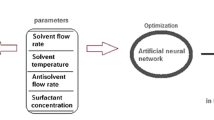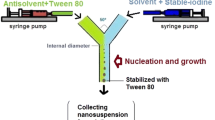Abstract
Nanoprecipitation is a simple and fast method to produce polymeric nanoparticles (Np); however, most applications require filtration or another separation technique to isolate the nanosuspension from aggregates or polydisperse particle production. In order to avoid variability introduced by these additional steps, we report here a systematic study of the process to yield monomodal and uniform Np production with the nanoprecipitation method. To further identify key variables and their interactions, we used artificial neural networks (ANN) to investigate the multiple variables which influence the process. In this work, a polymethacrylate derivative was used for Np (NpERS) and a database with several formulations and conditions was developed for the ANN model. The resulting ANN model had a high predictability (> 70%) for NpERS characteristics measured (mean size, PDI, zeta potential, and number of particle populations). Moreover, the model identified production variables leading to polymer supersaturation, such as mixing time and turbulence, as key in achieving monomodal and uniform NpERS in one production step. Polymer concentration and type of solvent, modifiers of polymer diffusion and supersaturation, were also shown to control NpERS characteristics. The ANN study allowed the identification of key variables and their interactions and resulted in a predictive model to study the NpERS production by nanoprecipitation. In turn, we have achieved an optimized method to yield uniform NpERS which could pave way for polymeric nanoparticle production methods with potential in biological and drug delivery applications.






Similar content being viewed by others
References
Bunjes H. Lipid nanoparticles for the delivery of poorly water-soluble drugs. J Pharm Pharmacol. 2010;62(11):1637–45. https://doi.org/10.1111/j.2042-7158.2010.01024.x.
Kipp JE. The role of solid nanoparticle technology in the parenteral delivery of poorly water-soluble drugs. Int J Pharm. 2004;284(1–2):109–22. https://doi.org/10.1016/j.ijpharm.2004.07.019.
A. Kumar, H. M. Mansour, A. Friedman and E. R. Blough, Nanomedicine in drug delivery, CRC, 2013, doi: https://doi.org/10.1201/b14802.
Merisko-Liversidge EM, Liversidge GG. Drug nanoparticles: formulating poorly water-soluble compounds. Toxicol Pathol. 2008;36(1):43–8. https://doi.org/10.1177/0192623307310946.
M. M. de Villiers, P. Aramwit and G. S. Kwon, Nanotechnology in drug delivery. Springer, 2008.
Fessi H, Puisieux F, Devissaguet JP, Ammoury N, Benita S. Nanocapsule formation by interfacial polymer deposition following solvent displacement. Int J Pharm. 1989;55(1):R1–4. https://doi.org/10.1016/0378-5173(89)90281-0.
Lepeltier E, Bourgaux C, Couvreur P. Nanoprecipitation and the “Ouzo effect”: application to drug delivery devices. Adv Drug Deliv Rev. 2014;71:86–97. https://doi.org/10.1016/j.addr.2013.12.009.
Schubert S, Joseph J, Delaney T, Schubert US. Nanoprecipitation and nanoformulation of polymers: from history to powerful possibilities beyond poly(lactic acid). Soft Matter. 2011;7(5):1581–8. https://doi.org/10.1039/C0SM00862A.
Baby T, Liu Y, Middelberg APJ, Zhao C-X. Fundamental studies on throughput capacities of hydrodynamic flow-focusing microfluidics for producing monodisperse polymer nanoparticles. Chem Eng Sci. 2017;169:128–39. https://doi.org/10.1016/j.ces.2017.04.046.
Albisa A, Piacentini E, Sebastian V, Arruebo M, Santamaria J, Giorno L. Preparation of drug-loaded PLGA-PEG nanoparticles by membrane-assisted nanoprecipitation. Pharm Res. 2017;34(6):1296–308. https://doi.org/10.1007/s11095-017-2146-y.
Allen S, Osorio O, Liu Y-G, Scott E. Facile assembly and loading of theranostic polymersomes via multi-impingement flash nanoprecipitation. J Control Release. 2017;262:91–103. https://doi.org/10.1016/j.jconrel.2017.07.026.
Beck-Broichsitter M, Nicolas J, Couvreur P. Solvent selection causes remarkable shifts of the “Ouzo region” for poly(lactide-co-glycolide) nanoparticles prepared by nanoprecipitation. Nanoscale. 2015;7(20):9215–21. https://doi.org/10.1039/C5NR01695A.
Yang Z, Foster D, Dhinojwala A. Continuous production of polymer nanoparticles using a membrane-based flow cell. J Colloid Interface Sci. 2017;501:150–5. https://doi.org/10.1016/j.jcis.2017.04.044.
Vitale SA, Katz JL. Liquid droplet dispersions formed by homogeneous liquid−liquid nucleation: “The Ouzo Effect.” Langmuir. 2003;19(10):4105–10. https://doi.org/10.1021/la026842o.
Aubry J, Ganachaud F, Cohen Addad J-P, Cabane B. Nanoprecipitation of polymethylmethacrylate by solvent shifting: 1. Boundaries. Langmuir. 2009;25(4):1970–9. https://doi.org/10.1021/la803000e.
Legrand P, Lesieur S, Bochot A, Gref R, Raatjes W, Barratt G, et al. Influence of polymer behaviour in organic solution on the production of polylactide nanoparticles by nanoprecipitation. Int J Pharm. 2007;344(1-2):33–43. https://doi.org/10.1016/j.ijpharm.2007.05.054.
Sommerfeld P, Schroeder U, Sabel BA. Long-term stability of PBCA nanoparticle suspensions suggests clinical usefulness. Int J Pharm. 1997;155(2):201–7. https://doi.org/10.1016/S0378-5173(97)00153-1.
Gaumet M, Vargas A, Gurny R, Delie F. Nanoparticles for drug delivery: the need for precision in reporting particle size parameters. Eur J Pharm Biopharm. 2008;69(1):1–9. https://doi.org/10.1016/j.ejpb.2007.08.001.
Di Pasquale N, Marchisio DL, Barresi AA. Model validation for precipitation in solvent-displacement processes. Chem Eng Sci. 2012;84:671–83. https://doi.org/10.1016/j.ces.2012.08.043.
Horn D, Rieger J. Organic nanoparticles in the aqueous phase—theory, experiment, and use. Angew Chem Int Ed. 2001;40(23):4330–61. https://doi.org/10.1002/1521-3773(20011203)40:23<4330::AID-ANIE4330>3.0.CO;2-W.
Lince F, Marchisio DL, Barresi AA. Strategies to control the particle size distribution of poly-ε-caprolactone nanoparticles for pharmaceutical applications. J Colloid Interface Sci. 2008;322(2):505–15. https://doi.org/10.1016/j.jcis.2008.03.033.
Matteucci ME, Hotze MA, Johnston KP, Williams RO. Drug nanoparticles by antisolvent precipitation: mixing energy versus surfactant stabilization. Langmuir. 2006;22(21):8951–9. https://doi.org/10.1021/la061122t.
Rao JP, Geckeler KE. Polymer nanoparticles: preparation techniques and size-control parameters. Prog Polym Sci. 2011;36(7):887–913. https://doi.org/10.1016/j.progpolymsci.2011.01.001.
Bilati U, Allémann E, Doelker E. Strategic approaches for overcoming peptide and protein instability within biodegradable nano- and microparticles. Eur J Pharm Biopharm. 2005;59(3):375–88. https://doi.org/10.1016/j.ejpb.2004.10.006.
Bodmeier R, Chen H, Tyle P, Jarosz P. Spontaneous formation of drug-containing acrylic nanoparticles. J Microencapsul. 1991;8(2):161–70. https://doi.org/10.3109/02652049109071485.
Hoffart V, Lamprecht A, Maincent P, Lecompte T, Vigneron C, Ubrich N. Oral bioavailability of a low molecular weight heparin using a polymeric delivery system. J Control Release. 2006;113(1):38–42. https://doi.org/10.1016/j.jconrel.2006.03.020.
Jiao Y, Ubrich N, Marchand-Arvier M, Vigneron C, Hoffman M, Lecompte T, et al. In vitro and in vivo evaluation of oral heparin-loaded polymeric nanoparticles in rabbits. Circulation. 2002;105(2):230–5. https://doi.org/10.1161/hc0202.101988.
Pignatello R, Bucolo C, Ferrara P, Maltese A, Puleo A, Puglisi G. Eudragit RS100® nanosuspensions for the ophthalmic controlled delivery of ibuprofen. Eur J Pharm Sci. 2002;16(1-2):53–61. https://doi.org/10.1016/S0928-0987(02)00057-X.
Gargouri M, Sapin A, Bouali S, Becuwe P, Merlin JL, Maincent P. Optimization of a new non-viral vector for transfection: Eudragit nanoparticles for the delivery of a DNA plasmid. Technol Cancer Res Treat. 2009;8(6):433–43. https://doi.org/10.1177/153303460900800605.
Seremeta KP, Chiappetta DA, Sosnik A. Poly(ɛ-caprolactone), Eudragit® RS 100 and poly(ɛ-caprolactone)/Eudragit® RS 100 blend submicron particles for the sustained release of the antiretroviral efavirenz. Colloids Surf B Biointerfaces. 2013;102:441–9. https://doi.org/10.1016/j.colsurfb.2012.06.038.
Agatonovic-Kustrin S, Beresford R. Basic concepts of artificial neural network (ANN) modeling and its application in pharmaceutical research. J Pharm Biomed Anal. 2000;22(5):717–27. https://doi.org/10.1016/S0731-7085(99)00272-1.
Colbourn EA, Rowe RC. Novel approaches to neural and evolutionary computing in pharmaceutical formulation: challenges and new possibilities. Future Med Chem. 2009;1(4):713–26. https://doi.org/10.4155/fmc.09.57.
Achanta AS, Kowalski JG, Rhodes CT. Artificial neural networks: implications for pharmaceutical sciences. Drug Dev Ind Pharm. 1995;21(1):119–55. https://doi.org/10.3109/03639049509048099.
Díaz-Rodríguez P, Landin M. Smart design of intratumoral thermosensitive β-lapachone hydrogels by artificial neural networks. Int J Pharm. 2012;433(1–2):112–8. https://doi.org/10.1016/j.ijpharm.2012.05.008.
Kazazi-Hyseni F, Landin M, Lathuile A, Veldhuis GJ, Rahimian S, Hennink WE, et al. Computer modeling assisted design of monodisperse PLGA microspheres with controlled porosity affords zero order release of an encapsulated macromolecule for 3 months. Pharm Res. 2014;31(10):2844–56. https://doi.org/10.1007/s11095-014-1381-8.
Landin M, Rowe RC. In: Aguilar JE, editor. Formulation tools for pharmaceutical development. Oxford: Woodhead; 2013. p. 7–37.
Landín M, Rowe RC, York P. Advantages of neurofuzzy logic against conventional experimental design and statistical analysis in studying and developing direct compression formulations. Eur J Pharm Sci. 2009;38(4):325–31. https://doi.org/10.1016/j.ejps.2009.08.004.
Rowe RC, Colbourn EA. Computers in pharmaceutical formulation. In: Ekins S, editor. Computer applications in pharmaceutical research and development. New York: Wiley; 2006. p. 677–701.
Colbourn E, Rowe RC. Encyclopedia of pharmaceutical technology. New York: Marcel Dekker; 2005. p. 145–57.
Johnson BK, Prud’homme RK. Mechanism for rapid self-assembly of block copolymer nanoparticles. Phys Rev Lett. 2003;91(11):118302. https://doi.org/10.1103/PhysRevLett.91.118302.
Molpeceres J, Guzman M, Aberturas MR, Chacon M, Berges L. Application of central composite designs to the preparation of polycaprolactone nanoparticles by solvent displacement. J Pharm Sci. 1996;85(2):206–13. https://doi.org/10.1021/js950164r.
Stepanyan R, Lebouille JGJL, Slot JJM, Tuinier R, Stuart MAC. Controlled nanoparticle formation by diffusion limited coalescence. Phys Rev Lett. 2012;109(13):138301. https://doi.org/10.1103/PhysRevLett.109.138301.
Xu J, Zhang S, Machado A, Lecommandoux S, Sandre O, Gu F, et al. Controllable microfluidic production of drug-loaded PLGA nanoparticles using partially water-miscible mixed solvent microdroplets as a precursor. Sci Rep. 2017;7(1):4794. https://doi.org/10.1038/s41598-017-05184-5.
Tan Y, Xu K, Li L, Liu C, Song C, Wang P. Fabrication of size-controlled starch-based nanospheres by nanoprecipitation. ACS Appl Mater Interfaces. 2009;1(4):956–9. https://doi.org/10.1021/am900054f.
Badri W, Miladi K, Nazari QA, Fessi H, Elaissari A. Effect of process and formulation parameters on polycaprolactone nanoparticles prepared by solvent displacement. Colloids Surf Physicochem Eng Asp. 2017;516:238–44. https://doi.org/10.1016/j.colsurfa.2016.12.029.
Choi S-W, Kwon H-Y, Kim W-S, Kim J-H. Thermodynamic parameters on poly(D,L-lactide-co-glycolide) particle size in emulsification-diffusion process. Colloids Surf Physicochem Eng Asp. 2002;201(1-3):283–9. https://doi.org/10.1016/S0927-7757(01)01042-1.
Galindo-Rodriguez S, Allémann E, Fessi H, Doelker E. Physicochemical parameters associated with nanoparticle formation in the salting-out, emulsification-diffusion, and nanoprecipitation methods. Pharm Res. 2004;21(8):1428–39. https://doi.org/10.1023/B:PHAM.0000036917.75634.be.
J. H. Kim, T. K. Ryu, K. Y. Jeong, D.-H. Paik, S.-K. Moon and S.-W. Choi, J Pharm Investig, 2014, 45, 157–161.
Van Krevelen DW, Te Nijenhuis K. In: Van Krevelen DW, Nijenhuis KT, editors. Properties of polymers (fourth edition). Amsterdam: Elsevier; 2009. p. 189–227.
Derlacki ZJ, Easteal AJ, Edge AVJ, Woolf LA, Roksandic Z. Diffusion coefficients of methanol and water and the mutual diffusion coefficient in methanol-water solutions at 278 and 298 K. J Phys Chem. 1985;89(24):5318–22. https://doi.org/10.1021/j100270a039.
Wang C-C, Zhang G, Shah NH, Infeld MH, Waseem Malick A, McGinity JW. Influence of plasticizers on the mechanical properties of pellets containing Eudragit® RS 30 D. Int J Pharm. 1997;152(2):153–63. https://doi.org/10.1016/S0378-5173(97)00080-X.
Ganachaud F, Katz JL. Nanoparticles and nanocapsules created using the Ouzo effect: spontaneous emulsification as an alternative to ultrasonic and high-shear devices. ChemPhysChem. 2005;6(2):209–16. https://doi.org/10.1002/cphc.200400527.
Hornig S, Heinze T. Efficient approach to design stable water-dispersible nanoparticles of hydrophobic cellulose esters. Biomacromolecules. 2008;9(5):1487–92. https://doi.org/10.1021/bm8000155.
Quintanar-Guerrero D, Allémann E, Fessi H, Doelker E. Preparation techniques and mechanisms of formation of biodegradable nanoparticles from preformed polymers. Drug Dev Ind Pharm. 1998;24(12):1113–28. https://doi.org/10.3109/03639049809108571.
Sternling CV, Scriven LE. Interfacial turbulence: hydrodynamic instability and the marangoni effect. AICHE J. 1959;5(4):514–23. https://doi.org/10.1002/aic.690050421.
Prasad KN, Luong TT, FlorenceJoelle Paris AT, Vaution C, Seiller M, Puisieux F. Surface activity and association of ABA polyoxyethylene–polyoxypropylene block copolymers in aqueous solution. J Colloid Interface Sci. 1979;69(2):225–32. https://doi.org/10.1016/0021-9797(79)90151-6.
Funding
The authors acknowledge the funding support from FONDECYT 11130235 and FONDAP 15130011.
Author information
Authors and Affiliations
Corresponding author
Ethics declarations
Conflict of interest
The authors declare that they have no conflict of interest.
Electronic supplementary material
ESM 1
(PDF 784 kb)
Rights and permissions
About this article
Cite this article
Jara, M.O., Catalan-Figueroa, J., Landin, M. et al. Finding key nanoprecipitation variables for achieving uniform polymeric nanoparticles using neurofuzzy logic technology. Drug Deliv. and Transl. Res. 8, 1797–1806 (2018). https://doi.org/10.1007/s13346-017-0446-8
Published:
Issue Date:
DOI: https://doi.org/10.1007/s13346-017-0446-8




